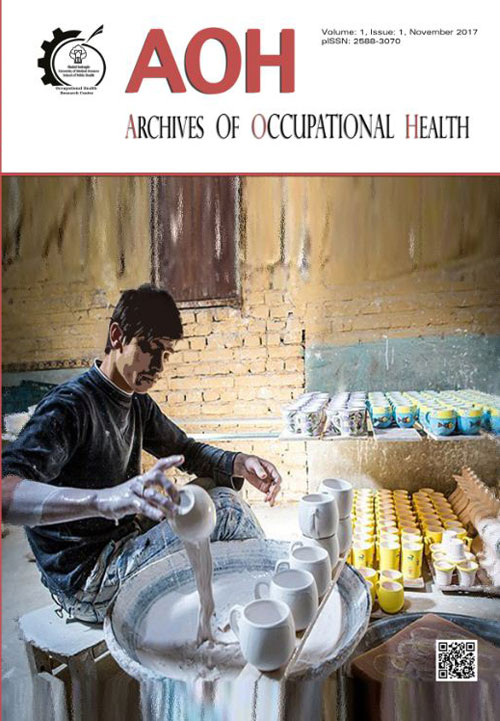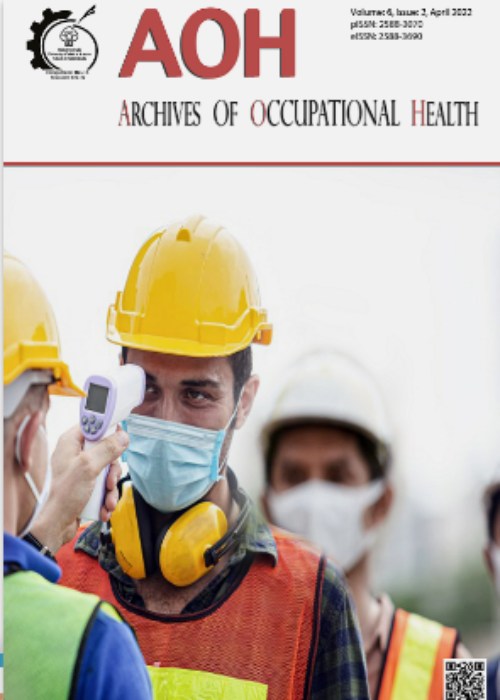فهرست مطالب

Archives Of Occupational Health
Volume:1 Issue: 1, Oct 2017
- تاریخ انتشار: 1396/08/03
- تعداد عناوین: 8
-
Page 1
The world is changing and the landscape of factories, workshops, and industries also changed. Many of new businesses and job titles did not exist in even ten years ago. In other words, our lifestyles, prosperities, and resources have changed since the last decade. However, on the other side, human beings are encountered with new challenges and hazards. The speed of change in the world is much higher than the change speed in identification, assessment, and regulation of the exposure to new hazardous situations or materials. So, harder work is required on the identification and assessment of these emerging situations to investigate possible unwanted health effects of new technologies and work relationships. On the other side of the coin, the occupational health problems in under-developed and less developed countries are caused by production methods and instruments that in some cases have several centuries of age. Since Asian and Middle East countries are somewhat different from European and North American countries, most of applied studies and health system researches conducted in the former region are not considered valid by the later countries.
Regarding the above mentioned points, Archives of Occupational Health (AOH), is aimed to publish applied studies on all relevant fields about occupational health. The most important issue in this journal is the quality and applicability of the findings. Archives of Occupational Health targets at publishing the high-quality applied researches in the fields of occupational and environmental health and safety, inhalation exposure assessment, method development, ergonomics, and epidemiology. The accepted manuscripts will be published on the journals website as well as printed version of the journal in English (However, we are working hard to add Arabic abstract, because one of the most important missions of our journal is to disseminate the results to the less developed countries, mainly Middle East countries). Our success in this mission largely depends on the kind support of all researchers and practitioners of the relevant fields. We are looking forward to see your valuable manuscripts in AOH. -
Pages 2-5BackgroundNickel is a toxic metal used as a pigment in ceramics industries. The purpose of this study was to assess inhalation exposure to nickel in the breathing zone of glazers and non-exposed group of workers. We also compared pulmonary function between ceramic glazers and the non-exposed group.MethodsIn this cross-sectional study, 49 glazers and 55 office workers were investigated. Air sampling in the breathing zone of each glazer was taken on a cellulose ester membrane filter with 37-mm diameter. The samples were then analyzed by inductively coupled plasma-atomic emission spectroscopy (ICP-AES). All the participants were required to fill out questionnaires on descriptive information. The parameters of pulmonary function were measured for both exposed and non-exposed participants.ResultsThe mean nickel concentration in the breathing zone of glazers was 0.09 mg/m3. Glazers had a significantly lower parameters of pulmonary function than office workers (pConclusionIn factories where local or general control is not feasible, workers must use personal protective equipments. Workers also should not be allowed to eat or smoke in the workplaces with toxic materials.Keywords: Nickel, Occupational Exposure, Inhalation Exposure, Air Pollution
-
Pages 6-12BackgroundMedical students are required to do part of their services in different shifts. This pattern can harm their health and education. This study was aimed to investigate the relationship between shift work and the health status of medical interns.MethodsThis cross-sectional study was conducted on 104 medical interns of Babol University of Medical Sciences, Iran. The data collection instrument included Survey of Shift workers (SOS) and Goldbergs General Health Questionnaire (GHQ-28). Descriptive statistics such as frequency and percentages, as well as analytical statistics (independent t-test, Chi-square, and correlation) was performed.ResultsAccording to the results, married and female students made up 75% and 18% of the participants, respectively. The mean age of participants was 25 ± 1 years. The statistical analysis showed that almost two thirds (71.6%) of students did not have appropriate mental health status and there was a significant relationship between mental health status and gastrointestinal problems (P= 0.041). There was a significant relationship between shift-work satisfaction and its adverse effects on student's family life (PConclusionThe results of this study indicated a high prevalence of shift work problems among medical interns. It is recommended to train medical interns about the effects of shift work problems on their life and possible solutions.Keywords: Sleep Disorders, Medical Students, Iran
-
Pages 13-17BackgroundRisk-taking behaviors and improper attitude toward occupational health and safety are the core of many occupational accidents and disorders. The aim of this study was to investigate the relationship between level of risk taking and level of safety culture in construction workers.MethodsThis cross-sectional study conducted on 38 construction workers. Demographic characteristics, risk-taking level (risky decision-making), and level of safety culture measured using specific questionnaires.ResultsThe mean score of safety culture was 245 across the research population. Overall, 13 participants had a safety culture score lower than 225 (coded as a negative safety culture), and 25 subjects had a safety culture score of over 225 (with a positive safety culture). Safety culture was significantly different among married and single subjects. However, there was no significant association between age, background, and level of education with the safety culture.ConclusionOur findings suggest that the level of education, age, and working background have no effect on safety culture. Effective measures should be taken to enhance safety culture in industrial environments.Keywords: Safety management, Construction industry, Risk-taking
-
Pages 18-22BackgroundIonizing radiation is one of the hazardous agents in the work place. It can cause serious and irreversible damage to the people exposed to it. Working in such environments can also causes chronic fatigue syndrome (CFS). The aim of this study was to investigate the prevalence of CFS in radiotherapists.MethodsThis study selected all men and women exposed to X-ray as the exposed group and nurses working in the same hospital as the control group. The sample size was considered of 46 radiotherapists and 46 nurses. Data on demographic characteristics and chronic fatigue syndrome were collected by the questionnaire.ResultsThe mean CFS score in all participants was 10.64±4.77. About 17.39% of them had fatigue syndrome. There was no significant difference between two groups in terms of fatigue syndrome (p=0.47). radiotherapists with more than 20 image taking per day had higher mean CFS; however, this relationship was not statistically significant (P>0.05).ConclusionChronic fatigue is multifactorial phenomenon in health care personnel. Workload is more important factor in development of chronic fatigue in radiotherapists.Keywords: Chronic fatigue syndrome, radiotherapists, nurses, occupational exposure
-
Pages 23-28BackgroundHeavy vehicle drivers are at risk of musculoskeletal disorders due to risk factors that are present in their job. The aim of this study was to investigate the prevalence and risk factors of musculoskeletal disorders in bus and truck drivers.MethodsThis cross-sectional study was carried out on 275 bus and 272 truck drivers using random sampling method. Nordic Musculoskeletal Questionnaire (NMQ) was used to assess the prevalence of musculoskeletal disorders. All analysis was performed by R software.ResultsThe mean age of bus and truck drivers was 42.74 and 39.76 years, respectively. In total, 26.9% of bus drivers and 31.6% of truck drivers reported pain in one of their nine body parts at least once during the previous year. The waist and knee with a prevalence of over 17% had the highest frequency. The results showed high frequency of exposure to vibration and smoking in the both groups. About 61% of drivers in both groups reported lack of job satisfaction.ConclusionThe prevalence of musculoskeletal disorders, especially low back pain in drivers was high. It seems that the development of an appropriate program for improving occupational health in drivers especially ergonomic interventions is necessary.Keywords: Musculoskeletal Diseases, Occupational Health, Human Engineering, Automobile Driving
-
Pages 29-34BackgroundPreparation of the test atmosphere is a crucial step in occupational health, toxicology, and analytical chemistry researches.MethodsA simple and efficient system was developed for preparation of standard test atmosphere for application in occupational and environmental exposure studies, especially passive sampler's validation.ResultsThe system applicability was tested in various temperature, humidity, and velocity conditions.Resultsshowed that for testing the adsorbent samplers, the system should be in hybrid mode of dilution.ConclusionThe repeatability of the measurements in the proposed system was also examined that was in acceptable range. With double dilution system it is possible to produce concentrations less than part per million.Keywords: Test Atmosphere Generation, Passive Samplers, Solid Phase Microextraction, Exposure Chamber, Air Pollution
-
Pages 35-41BackgroundOccupational accidents occur every day across industries. One of the probable causes of this occurrence is the sleep disorders. This study aims to investigate the relationship between the sleep disorders, and occupational accidents in a group of Iranian workers.MethodsA cross-sectional study was conducted on 366 workers of steel parts production industries in Kashan, Iran. A three-part questionnaire was used in the study. The first part covered the demographic characteristics of the workers, the second part was related to the Pittsburgh Sleep Quality Index for sleep disorders and the third part was related to the information on the accident occurrence in the workplace. The collected data were analyzed using SPSS software and analyzed with Pearson correlation coefficient, ANOVA and t-test.ResultsThe results of this study showed that the average score of sleep quality was 5.84 (standard deviation: 2.66). The sleep quality of 53.7% of the subjects was poor. Over the past year, 27.4% of the workers had an occupational incident. There was no significant relationship between sleep disorders and occurrence of occupational accidents (p> 0.05).ConclusionOur results showed that more than half of the workers suffered from poor sleep quality. However, there was no significant relationship between sleep disorders and occupational accidents.Keywords: Occupational Accidents, Sleep Wake Disorders, Occupational Health


